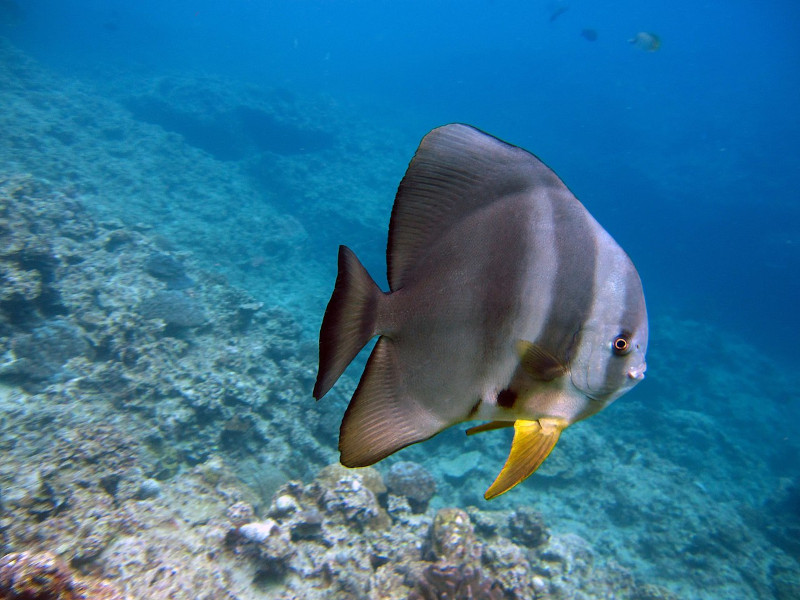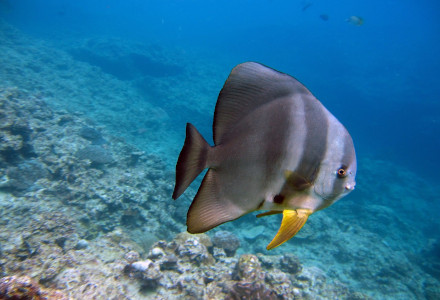
Photographer: Chinen Keiya
CC License: https://bit.ly/3j0JhLq
Longfin Batfish Facts
- Firstly, Longfin Batfish serves as the common name of the ocean species Platax teira. Due to its rather striking appearance, this fish, unfortunately, has become popular in aquariums.
- Furthermore, this somewhat unassuming looking fish also holds a few surprises. Among these is the fact that the animal ranks as one of the fastest growing creatures in any ocean.
- In addition, the fascinating species forms groups, called schools, like many fish. However, unlike others, this open-minded creature often includes members of other species in the school.
- Perhaps most notably, this ocean denizen often displays a strange affinity for boats. It seemingly enjoys swimming along underneath them. It also often approaches human divers.
- Finally, the creature appears to still be abundant in the wild, as well as captivity. Therefore, currently, the IUCN has no listing for it, despite the ever-increasing dangers of climate change.
Related Articles
Jawfish Spotted Handfish Sea Lamprey
Photographer: Keith DP Wilson
CC License: https://bit.ly/3l5lhtf
Longfin Batfish Physical Description
Perhaps most notably, an adult Longfin Batfish attains an average body length of about 27.5 in (70 cm). The species remains rather popular for its highly rounded and compressed body shape.
The color pattern also varies widely among individuals. However, combinations of a light brown or yellowish silver remain the most common patterns of color. There is also a small vertical bar, dark in color, across the face. But, a wider one develops behind the operculum.
The adults possess highly arched anal fins and a small bony bulge on the forehead. Yet, the juvenile Longfin Batfish develop distinctly different in appearance from the adults. It possesses a short body, extremely tall anal fins, and displays no bulge on the forehead.
- Kingdom: Animalia
- Phylum: Chordata
- Class: Actinopterygii
- Order: Perciformes
- Family: Ephippidae
- Genus: Platax
- Species: P. teira
Photographer: Alain Feulvarch
CC License: https://bit.ly/1ryPA8o
Longfin Batfish Distribution, Habitat, and Ecology
The native habitat range of the Longfin batfish covers most of the Indo-Pacific region. There it lives near the east coast of Africa and the Red Sea to Papua New Guinea. However, it also lives as far north as the Ryukyu Islands, and Australia in the south end of its range.
The majority of adults also usually prefer to inhabit seaward reefs and coastal lagoons. Meanwhile, the young typically stay in regions of seagrass meadows as well as areas of mangrove.
Further, the amazing Longfin Batfish primarily appears to prefer very shallow regions of the ocean. The fish also most commonly lives at depths only measuring roughly 65 ft (20 m).
Additionally, the ocean creature evolved as a full-fledged omnivore. Much like many related species, it generally feeds on a rather wide variety of small invertebrates, plankton, and marine algae.
Finally, despite rather intensive studies, an average lifespan in the wild remains unknown. However, those numerous individuals living in captivity live an average of roughly 14 years.
Species Sharing Its Range
Check out our other articles on 7 Fabulous South American Plants, Mongolian Wild Horse, Mount Erebus, Ascension Island Parsley Fern, Giant Leopard Moth, Puffin, King Cobra

